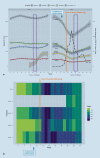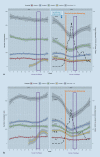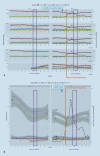Impact of the COVID-19 pandemic on emergency medical resources : An observational multicenter study including all hospitals in a major urban center of the Rhein-Ruhr metropolitan region
- PMID: 34292358
- PMCID: PMC8296826
- DOI: 10.1007/s00101-021-01005-7
Impact of the COVID-19 pandemic on emergency medical resources : An observational multicenter study including all hospitals in a major urban center of the Rhein-Ruhr metropolitan region
Abstract
Background: With the coronavirus disease 2019 (COVID-19) outbreak hospitals prepared for increasing numbers of patients without knowing how patient populations were evolving and what resources would be required. The present study aimed to analyze the impact of the local COVID-19 pandemic on emergency resources of all hospitals in a major urban center (Mönchengladbach) in Germany.
Methods: This observational multicenter study involved all acute care hospitals (n = 4). Systemic emergency department (ED) parameters from weeks 4-24 in 2020 were compared to the corresponding period in 2019 for each hospital and in a summative data analysis using a logistic regression model.
Results: The first regional COVID-19 patients were detected in week 9 of 2020. The cumulative number of ED visits dropped from 34,659 in 2019 to 28,008 in 2020. Weekly ED visits per hospital decreased from week 8 onwards between 38% and 48% per week and hospital and began to rise again after week 16. The pooled data analysis of ED patients showed significant decreases in outpatient visits (20,152 vs. 16,477, p < 0.001), hospital admissions (14,507 vs. 11,531, p < 0.001), and work-related accidents (2290 vs. 1468, p < 0.001). The decrease in ED to ICU admissions showed no significance (2093 vs. 1566, p = 0.255). The decline in ED cases was equally distributed between the medical specialties.
Conclusion: The regional COVID-19 outbreak led to significantly reduced ED contacts in a German major urban region after the first COVID-19 cases appeared. Both hospital admissions and the number of ED to ICU admissions decreased, whereas the ratio of emergency outpatients vs. inpatients remained stable. Therefore, it can be assumed that patients with severe medical problems did not seek emergency care. These secondary effects of the pandemic on healthcare and the socioeconomic impact should be analyzed further.
Zusammenfassung: HINTERGRUND: Zu Beginn der COVID-19-Pandemie im Jahr 2020 bereiteten sich das Gesundheitssystem und die Krankenhäuser in Deutschland auf höhere Patientenzahlen insgesamt und auch auf die Aufnahme zahlreicher kritisch kranker Patienten vor. Dazu mussten Ressourcen mobilisiert und Prozesse angepasst werden, die sowohl einem neuen Patientenkollektiv als auch der bisherigen Patientenversorgung gerecht werden sollten. Als eine der ersten deutschen Großstädte musste Mönchengladbach entsprechende Maßnahmen treffen, ohne dass die genauen Auswirkungen der Pandemie auf die Zusammensetzung der Patientenpopulationen abgeschätzt werden konnten bzw. bekannt war, ob ausreichend Notfallressourcen zur Verfügung stehen. In dieser Studie wird die Inanspruchnahme der kompletten Krankenhaus-Notfallstrukturen einer deutschen Großstadt zu Beginn der Corona-Pandemie analysiert.
Methoden: In dieser multizentrischen Observationsstudie aller (n = 4) Zentralen Notaufnahmen (ZNA) einer deutschen Großstadt (Mönchengladbach, ca. 274.000 Einwohner) wurde das Patientenaufkommen in den ZNA in den Kalenderwochen (KW) 4–24 im Jahr 2020 mit dem korrespondierenden Zeitraum (KW 4–24) in 2019 verglichen. Die weitere Auswertung erfolgte sowohl für jedes einzelne Krankenhaus als auch im kumulativen Gesamtvergleich in einer logistischen Regressionsanalyse. Aufgrund der voneinander unabhängigen Auswertungen der einzelnen Krankenhäuser wurde eine Bonferroni-Korrektur für das Signifikanzniveau durchgeführt.
Ergebnisse: Die ersten regionalen COVID-19-Patienten wurden in Woche 9 des Jahres 2020 entdeckt. Die kumulative Anzahl der Patienten in der ZNA sank von 34.659 im Jahr 2019 auf 28.008 im Jahr 2020. Die wöchentliche Anzahl pro Krankenhaus nahm ab Woche 8 zwischen 38% und 48% pro Woche und Krankenhaus ab und begann nach Woche 16 wieder zu steigen. Die gepoolte Datenanalyse des Patientenaufkommens in der ZNA zeigte einen signifikanten Rückgang ambulanter Notfallpatienten (20.152 vs. 16.477; p < <0,001), Notfallpatienten mit Bedarf zur stationären Behandlung (14.507 vs. 11.531; p < 0,001) und der Arbeitsunfälle (2290 vs. 1468; p < <0,001). Der Rückgang der Einweisungen von der Notaufnahme auf die Intensivstation zeigte keine Signifikanz (2093 vs. 1566; p = 0,255). Der Rückgang des Patientenaufkommens in den ZNA verteilte sich gleichmäßig auf die medizinischen Fachgebiete.
Schlussfolgerung: Der regionale COVID-19-Ausbruch führte in einer deutschen Großstadtregion nach dem Auftreten der ersten COVID-19-Fälle zu einem deutlich reduzierten Patientenaufkommen in den ZNA. Auch die Zahl von stationären Aufnahmen und Intensivaufnahmen war rückläufig, während das Verhältnis von ambulanten Notfallpatienten zu stationären Patienten stabil blieb. Daher kann davon ausgegangen werden, dass Patienten mit schweren medizinischen Problemen keine Notfallversorgung aufgesucht haben. Diese sekundären Effekte der Pandemie auf das Gesundheitswesen und die sozioökonomischen Auswirkungen sollten weiter analysiert werden.
Keywords: COVID-19; Emergency department; Inpatient admissions; Intensive care unit; Outpatient visits; Working accidents.
© 2021. Springer Medizin Verlag GmbH, ein Teil von Springer Nature.
Conflict of interest statement
S. Bergrath, T. Strapatsas, M. Tuemen, T. Reith, M. Deussen, O. Aretz, A. Hohn and A. Lahm declare that they have no competing interests.
Figures




References
Publication types
MeSH terms
Substances
LinkOut - more resources
Full Text Sources
Medical
